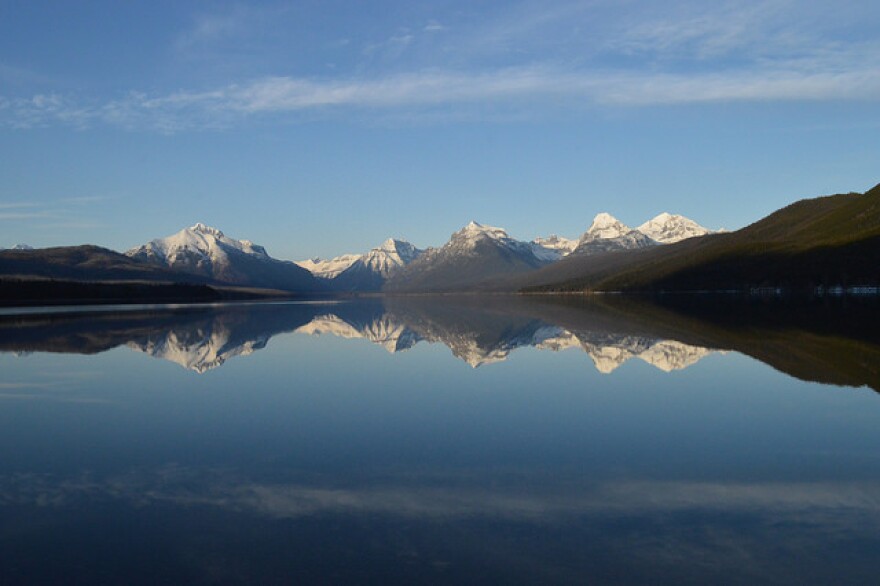This summer one tiny-shelled invertebrate has dominated the conversation about keeping non-native species out of Montana.
Since zebra and quagga mussel larvae were detected in Tiber Reservoir last summer, local, state, tribal and federal agencies have scrambled to enact programs and policies to keep the mussels out of Montana’s waterways.
For Glacier National Park, that meant banning all motorboats from park waters while the Park put together a plan to keep mussels out.
Michael Ryan owns private property, and a motorboat within park boundaries, and says that decision was overkill.
"It's never been anywhere but the lake. My argument with the government was they simply wanted to prevent the invasive mollusk species from coming in here, and there are a bunch of us who can prove our boats have never been anywhere else, but for a while they weren't listening," Ryan says.
Two weeks ago, Glacier announced it would start allowing people who own private land inside the park to use their motorboats on Lake McDonald following a 30-day quarantine, and would soon publicize instructions for non-local boaters.
Ryan says that’s what he and many of his neighbors wanted all along.

"I think it's fine as long as they do a rigorous inspection. I'd be perfectly willing to pay for a thorough inspection that might take an hour or an hour and a half. Charge $50 or $100 for that and I'd be happy to pay that. I'd like to protect the water the same as anybody else," he says.
On the same day the park announced its new relaxed and free policy, the Flathead Beacon newspaper reported the unexpected policy change came after pressure from Interior Secretary Ryan Zinke to lift restrictions barring motorized watercraft in the park. Zinke’s spokesperson denied the interference and issued a retraction of the park’s announcement, but the park is still moving forward with its relaxed motor-boating policy on Lake McDonald. Private property owners have been boating on the lake for more than a week, and soon the park will release a protocol for non-local boaters.
Glacier National Park and the Interior Department declined to comment on the park’s current mussel management strategy, but mussels are just one of many invasive species park managers are concerned about.
Chris Downs is the fisheries program manager at Glacier National Park.
"People come look out over Lake McDonald, see this beautiful lake, very clean water, but rarely do people get to stick their heads under the water and see what the aquatic ecosystem looks like under there, where we have a number of non-native species that are having adverse effects on our native aquatic systems," Downs says.
Downs does stick his head under the park’s waters, and he finds a lot of fish and plants that shouldn’t be there. And their presence in the park has a huge impact, not just on lakes and rivers, but on wildlife that depend on the park’s original native fish.
"We have grizzly bears that feed on Yellowstone cutthroat trout in Hidden Lake, for example, and we sure have loons that feed on native westslope cutthroat trout at our lower elevation lakes," he says. "When you start disrupting the food chain at the lower level, it has the potential to unravel those relationships with other levels of the natural environment in the park here."
Downs says the Park is working on a fisheries management plan to give some big picture guidance for what types of management projects should happen where. Invasive mussels will have their own, separate plan. Currently, Downs' two big projects run about $100,000 a year each. One seeks to get rid of invasive lake trout from Quartz Lake, and another re-introduces threatened, native bull trout into Logging Lake to restore natural conditions.
"Prevention is much less expensive than dealing with the problem after the fact," Downs says.
Dawn LeFleur tackles the park’s invasive weed species on land.
"My biggest fear is in 50 years they're going to ask why we didn't do more in terms of protecting the landscape from invasive species," LeFleur says.
Glacier has been working to contain non-native species since at least the 1970s. Along with preventing new non-native plants from entering the park, LaFleur oversees large scale weeding and spraying projects to try to combat and contain the weeds that already are here.
"We're not bringing it back to where it was successionally, or where it was before the disturbance, but we are helping it get a foothold, a jumpstart if you will, to becoming established and becoming a native plant community again," she explains.
LeFleur’s projects are often funded through donations and grants from the Glacier National Park Conservancy, the local non-profit fundraising partner for the park. Volunteers do a lot of the grunt work pulling weeds along roadsides and backcountry trails.
LeFleur takes me on a little walk around the parking lot at Park Headquarters near West Glacier. We find an invasive weed almost immediately.
"So, this is our number one bad guy, both in GNP and in northwest Montana," LeFleur says.
She holds up a purple blossom with petals like sea-anemone arms.
"This is spotted knapweed. It was brought into the Flathead Valley for honeybee production. For the most part, it's very, very invasive. This is the one that can produce up to 30,000 seeds. Also this plant produces a chemical from its roots that kills anything that's not just like it."

Spotted knapweed can take over entire hillsides and change the soil enough that native plants can’t grow there anymore. That’s exactly what LeFleur hopes to avoid, not just because the park is mandated by Congress to protect and conserve Glacier’s natural landscape, but because she wants visitors to have the full Glacier experience.
"As we see development all around the world, the need to be able to preserve and protect what we have here has become much more paramount, especially as we've got the science to back it up. If we don't do anything, we're really going to see changes in the park and the ecosystem, and that's going to have cascading effects all around," says LeFleur.
You can find more information about Glacier National Park’s invasive species management here.


